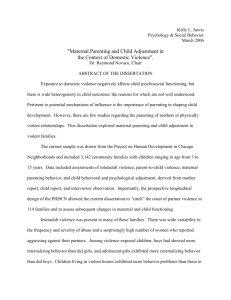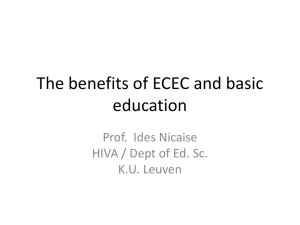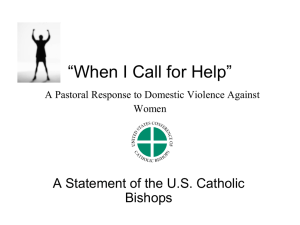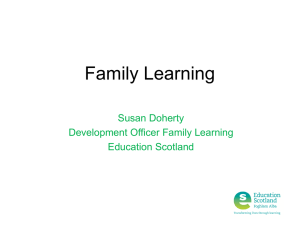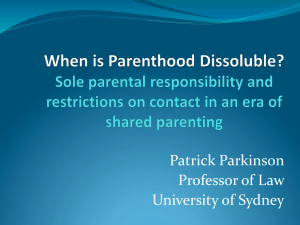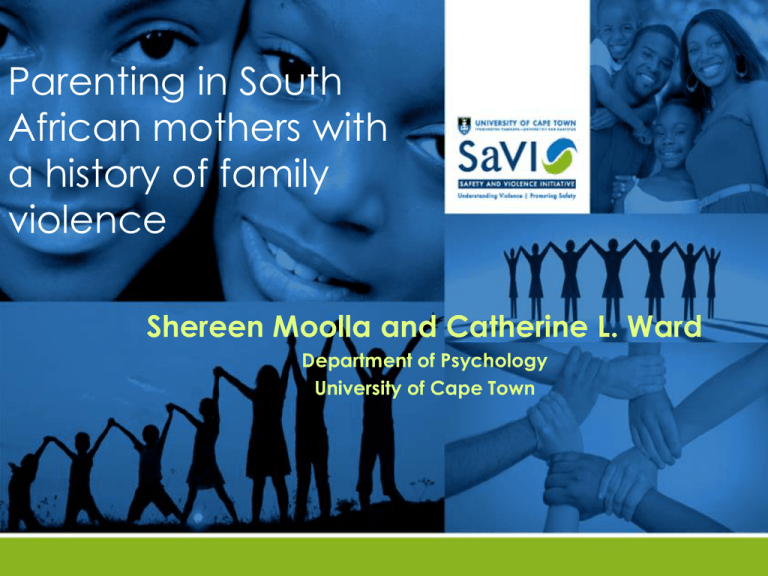
Parenting in South
African mothers with
a history of family
violence
Shereen Moolla and Catherine L. Ward
Department of Psychology
University of Cape Town
UCT’s Safety and Violence Initiative
(SaVI)
Engineering and the Built Environment:
Humanities:
Anthropology; linguistics; film & media studies; psychology;
religious studies; social development; sociology
Health sciences:
Town planning
Forensic medicine; Gender, Health & Justice Research Unit;
primary health care directorate; psychiatry; public health;
surgery
Law
Law, Race & Gender Research Unit; criminology; public law
This presentation
Some
background on intimate partner violence and
child maltreatment in South Africa
Family violence and parenting
Methodology for our study
Findings:
Demographics
Mothers’ histories of family violence
Mothers’ parenting
Children’s behaviour
Risk and protective factors
Relationships among variables
Interpretations
and implications
Thanks to:
Nicia
de Nobrega, Abigail Miles and Inge Wessels
The
Saartjie Baartman Centre, REACH, the New
World Foundation, Self-Help Mannenberg,
Carehaven, the Westlake Community Centre, Place
of Hope, Village Care, and the Islamic Resource
Foundation of South Africa
The
UCT University Research Committee and the
National Research Foundation
Intimate partner violence in SA
8.8%
of men working in the Cape Town municipality
report IPV against a partner in the last year (Abrahams et
al., 2006)
At
least half of female homicide victims are killed by
their intimate partners (Seedat et al., 2009):
In 1999, this was therefore at least 1,899 women, or 12.4
per 100,000
The rate of homicide for women (all causes) is 6x the
average rate worldwide
Child maltreatment in South Africa
44.6% of the homicides due to CAN
35.7% of these due to abandonment in the first week after birth
74% of the CAN homicides among children aged 0-4
Mathews et al., 2012
Consequences of family violence
Increased
depression and anxiety
Increased
substance misuse
Internalised
problems
model of violence as a way to solve
Risk and protection for parenting
Risk factors
Protective factors
Intimate partner violence
Social support
Parent’s own child maltreatment
Higher maternal education
Substance misuse
Older maternal age
Parental mental illness
Parental competence
Poverty
Parental stress
Child behavioural
problems
Methodology
Mothers
were recruited from NGOs serving women
across Cape Town
Inclusion
criteria:
Women with a child aged 3-8
The child’s behaviour concerned mother
Had not received any parenting intervention
Interviewed
215 women, excluded 12:
4 had children > 8
6 had too much missing data
2 had either a “yes” or a “no” response set
Measures
Demographics
CTS-2
- intimate partner violence
ICAST-R
- history of childhood abuse
PC-CTS
- parent/child conflict
ECBI
- child behaviour problems
PSOC
PSI
- parent competence
- parental stress
GHQ
- maternal mental health
ASSIST
- substance misuse
Duke
Social Support Scale
Demographics
Mean age: 32.4 years old.
Marital status: mostly single (46.80%).
Language: mostly Afrikaans and isiXhosa (38.42 % and 42.37%)
respectively.
Children: 65% had more than one child
82.76% were unemployed
Education: 62.56% of the participants had not completed high
school
Housing:
53.21% participants lived in formal housing
16.26% l in outbuildings in someone’s backyard
8.87% in shacks
20.20% in flats
13% of the women interviewed were living in shelters for
abused women at the time of the interview.
Poverty
Access
to electricity, a phone, a television and a
private motor-car: 12.32% had access to all four
commodities.
Food
security: 72.91% had ‘run out of money to buy
food at least once that year’
34.48%
81%
‘had to go to bed hungry sometimes’
received the child support grant
Mothers’ history of IPV
Subscale
%
n
Psychological Abuse - minor
83.74
170
Psychological Abuse - severe
66.51
135
Physical Abuse - minor
73.40
149
Physical Abuse - severe
53.69
109
Sexual Abuse - minor
43.35
88
Sexual Abuse - severe
22.17
45
Injury - minor
54.19
110
Injury - severe
39.41
80
Mothers’ history of child abuse
Type of child abuse
n
%
Hit, punched or kicked
81
39.9%
Beaten with an object
92
45.3%
Stabbed or cut
20
9.9%
Exposure to other’s genitals
30
14.8%
Forced to pose naked
1
0.5%
Unwanted touching of genitals
30
14.8%
Forced to touch other’s genitals
18
8.9%
Forced sexual intercourse
18
8.9%
Ever told anyone about unwanted sexual experiences
14
6.9%
What parenting techniques did
parents use?
n
%
Mean
SD
Non-Violent Discipline
194
95.57
6.07
3.09
Psychological Aggression
192
94.58
5.87
3.45
Minor Assault
190
93.60
5.22
3.36
Severe Assault
80
39.41
1.14
1.86
Very Severe Assault
34
16.75
0.37
1.01
Children’s behaviour
Above cut-off
Intensity
Problem
n
%
n
%
56
27.6
85
41.9
Other factors
Risk/protective factor
n
%
High parenting stress scores
196
96.6%
Achieved ‘caseness’ on the GHQ
139
68.5%
Risky use of tobacco
107
52.7%
Risky use of alcohol
47
23.2%
Risky use of cannabis
15
7.4%
Risky use of cocaine
1
0.5%
Risky use of amphetamines
13
6.4%
Risky use of inhalants
1
0.5%
Risky use of sedatives
10
4.9%
At least moderate social support
126
62.1%
Moderate-high parental incompetence
178
87.7%
Relationships among variables
Higher maternal age was associated with child
behaviour problems
Running out of money for food was associated with child
behaviour problems
Getting income from work was associated with child
behaviour problems
Mothers’ histories of family violence were significantly
associated with child behaviour problems
This relationship is mediated by parental stress, parent-child
conflict and parental competence
But not by maternal mental health, substance misuse, or
social support
Implications
If
women seek help for parenting, ask about their
histories of family violence
If
women seek help for family violence, ask about
their children’s wellbeing
Prevent
child maltreatment and intimate partner
violence
Programmes
that boost parental competence –
parent training programmes – may well reduce
parental stress and improve child behaviour

